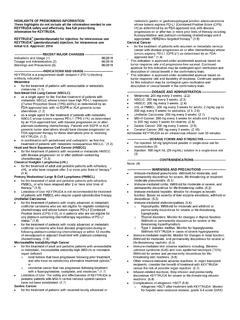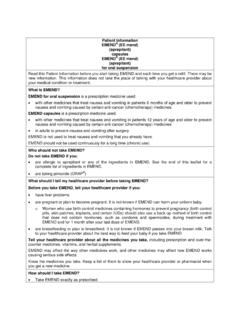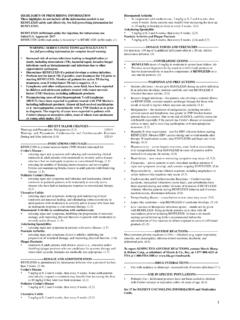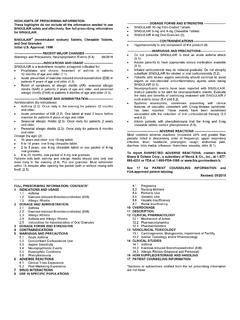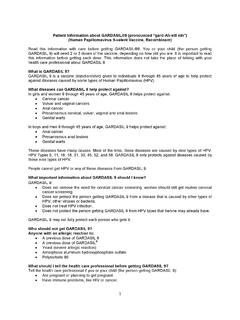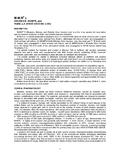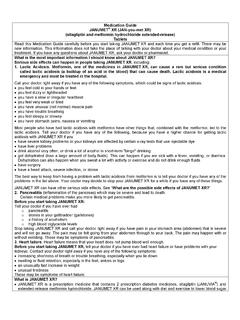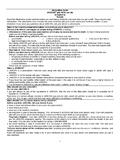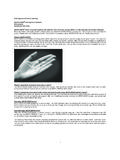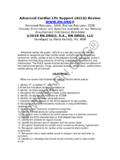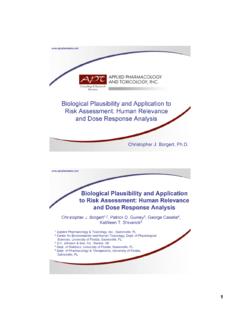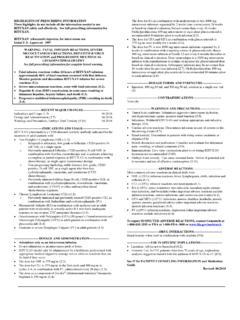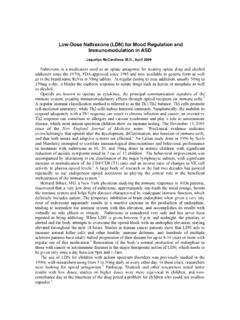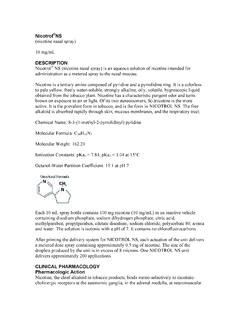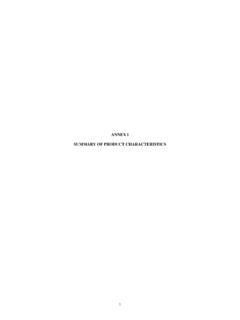Transcription of HIGHLIGHTS OF PRESCRIBING INFORMATION …
1 HIGHLIGHTS OF PRESCRIBING INFORMATIONT hese HIGHLIGHTS do not include all the INFORMATION needed to use BRIDION safely and effectively. See full PRESCRIBING INFORMATION for (sugammadex) Injection, for intravenous useInitial Approval: 2015----------------------------INDICATI ONS AND USAGE----------------------------BRIDION is indicated forthereversal of neuromuscular blockade induced by rocuronium bromide and vecuronium bromide in adultsundergoing surgery. (1)-----------------------DOSAGE AND ADMINISTRATION----------------------- Monitor for twitch responses to determine thetiming and dose forBRIDION administration.(2) Administer as a single bolus injection. (2)For rocuronium and vecuronium: 4 mg/kg is recommended if spontaneous recovery of the twitch response has reached 1 to 2 post-tetanic counts (PTC)and there are notwitch responses totrain-of-four (TOF)stimulation.
2 ( ) 2 mg/kg is recommended if spontaneous recovery has reached the reappearance of the second twitch in response to TOF stimulation.( )For rocuroniumonly: 16 mg/kg is recommended if there is a clinicalneed to reverse neuromuscular blockade soon (approximately 3 minutes) afteradministration of a singledose mg/kg of rocuronium.( )---------------------DOSAGE FORMS AND STRENGTHS--------------------- 200 mg/2 mL(100mg/mL) in a single-dose vial for bolus injection (3) 500 mg/5 mL(100 mg/mL) in a single-dose vial for bolus injection(3)---------------------------- ---CONTRAINDICATIONS-------------------- -----------Known hypersensitivity to sugammadex or any of its components. (4)-----------------------WARNINGS AND PRECAUTIONS------------------------ Anaphylaxis: Anaphylaxis has occurred in of healthy volunteers. Observe patients for an appropriate period of time after administration.
3 ( ) Marked Bradycardia: Cases of marked bradycardia, some of which have resulted in cardiac arrest, have been observed within minutes after administration. Monitor for hemodynamic changes andadminister anticholinergicagents such as atropine if clinically significant bradycardia is observed. ( ) Respiratory Function Monitoring: Ventilatory support is mandatory for patients until adequate spontaneous respiration is restoredand the ability to maintain a patent airway is neuromuscular blockade persist after BRIDION or recur following extubation, take appropriate steps to provide adequate ventilation. ( , ) Waiting Times for Re-Administration of Neuromuscular Blocking Agent: If re-administration of a neuromuscular blocking agent is required after reversalwith BRIDION, waiting times should be based on the dose of BRIDION, and the renal function of the use of a nonsteroidal neuromuscular blocking agent.
4 ( )------------------------------ADVERSE REACTIONS------------------------------M ost common adverse reactions (reported in 10% of patients at a 2, 4, or 16 mg/kgBRIDION doseand higher thanthe placebo rate):vomiting, pain, nausea, hypotension, and headache. ( )To report SUSPECTED ADVERSE REACTIONS, contact Merck Sharp & Dohme Corp.,a subsidiary of Merck & Co., Inc., at 1-877-888-4231 or FDA at 1-800-FDA-1088 or INTERACTIONS---------------------------- --- Toremifene: Recovery could be delayed in patients using toremifene. ( ) Hormonal contraceptives: Patients using hormonal contraceptivesmust use an additional, non-hormonal method of contraception for the next 7 days following BRIDION administration. ( , )-----------------------USE IN SPECIFIC POPULATIONS----------------------- Pediatrics: Safety and effectiveness of BRIDION have not been establishedin patients 17 years of age.
5 ( ) Severe Renal Impairment: Not recommended. ( )See 17 for PATIENT COUNSELING : 12/2018 FULL PRESCRIBING INFORMATION : CONTENTS*1 INDICATIONS AND USAGE2 DOSAGE AND Compatibility3 DOSAGE FORMS AND STRENGTHS4 CONTRAINDICATIONS5 WARNINGS AND and Function Monitoring During of Prolonged Neuromuscular Times for Re-Administration of Neuromuscular Blocking Agents for Intubation Following Reversal with BRIDION Potentially Affecting the Efficacy of of Recurrence of Neuromuscular Blockade Due to Displacement of Recurrence of Neuromuscular Blockade with Lower Than Recommended of Recurrence of Neuromuscular BlockadeDue to the Administration of Drugsthat Potentiate Neuromuscular of Coagulopathy and after Rocuronium or Vecuronium Administration in the of Neuromuscular Blocking Agents Other Than Rocuronium or Vecuronium6 ADVERSE Trials DRUG Potentially Affecting the Efficacy of Potentially
6 Affecting the Efficacy of Hormonal with Laboratory Tests8 USE IN SPECIFIC and Males of Reproductive Renal Hepatic Patients10 OVERDOSAGE11 DESCRIPTION12 CLINICAL of NONCLINICAL , Mutagenesis, Impairment of Toxicology and/or Pharmacology14 CLINICAL Clinical Studies16 HOW SUPPLIED/STORAGE AND HANDLING17 PATIENT COUNSELING INFORMATION *Sections or subsections omitted from the full PRESCRIBING INFORMATION are not PRESCRIBING INFORMATION1 INDICATIONS AND USAGEBRIDION is indicated for the reversal of neuromuscular blockade induced byrocuroniumbromide andvecuroniumbromide in adultsundergoing AND ADMINISTRATIONBRIDION(sugammadex) injection, for intravenous use, should be administered by trained healthcare providers familiar with the use, actions, characteristics, and complications of neuromuscular blocking agents (NMBA) and neuromuscular block reversal and timing of BRIDION administration should be based on monitoring for twitch responses and the extent of spontaneous recovery that has BRIDION intravenously as a single bolus injection.
7 The bolus injection may be given over10 seconds, intoan existing intravenous line. BRIDIONhas only been administered as a single bolus injection in clinical the time of BRIDION administration until complete recovery of neuromuscular function, monitor the patient to assure adequateventilationand maintenance of a patent airway. Satisfactory recovery should be determined throughassessment of skeletal muscle tone and respiratory measurements in addition to the response to peripheral nerve recommended dose of BRIDION does not depend on the anesthetic DosingBRIDION can be used to reverse different levels of rocuronium- or vecuronium-induced neuromuscular rocuronium and vecuronium: A dose of 4mg/kg BRIDIONis recommended if spontaneous recovery of the twitch response has reached 1 to 2 post-tetanic counts (PTC)and there are no twitch responses to train-of-four (TOF)stimulationfollowing rocuronium- or vecuronium-induced neuromuscular blockade [see Warnings and Precautions ( )].
8 A dose of 2 mg/kg BRIDIONis recommended if spontaneous recovery has reached the reappearance of the second twitch (T2) in response to TOF stimulationfollowing rocuronium- or vecuronium-induced neuromuscular blockade [see Warnings and Precautions ( )].For rocuronium only: A dose of 16mg/kg BRIDIONis recommended if there is a clinicalneed to reverse neuromuscular blockade soon (approximately 3 minutes) afteradministration of a singledose of efficacy of the 16mg/kg dose of BRIDION following administration of vecuronium has not been studied[see Clinical Studies ( )].BRIDION dosing is based on actual body Drug CompatibilityMay inject BRIDION into the intravenous line of a running infusion with the following intravenous solutions: sodium chloride 5% dextrose3 sodium chloride and dextrose 5% dextrose in sodium chloride isolyte P with 5% dextrose Ringer s lactate solution Ringer s solutionEnsure theinfusion line is adequately flushed ( , with sodium chloride) between administration of BRIDIONand other not mix BRIDION with other products except those listed is physically incompatible with verapamil, ondansetron, and inspect parenteral drug products for particulate matter and discoloration prior to administration, whenever the solution and container FORMS AND STRENGTHSBRIDION(sugammadex) injection is a sterile, clear, colorless to slightly yellow-brown, non-pyrogenic aqueous solution intended for intravenous infusion.
9 BRIDION is available as follows: 200mg/2 mL(100 mg/mL)in a single-dose vialfor bolus injection 500mg/5 mL(100 mg/mL), in a single-dosevial for bolus injection4 CONTRAINDICATIONSBRIDIONis contraindicated in patients with known hypersensitivity to sugammadex or any of its components. Hypersensitivity reactions that occurred varied from isolated skin reactions to serious systemic reactions ( , anaphylaxis, anaphylactic shock) and have occurred in patients with no prior exposure to sugammadex [see Warnings and Precautions ( ), Adverse Reactions (6)].5 WARNINGS AND Anaphylaxis andHypersensitivityClinicians should be prepared for the possibility of drug hypersensitivity reactions (including anaphylactic reactions) and take the necessary precautions[see Contraindications (4), Adverse Reactions ( )].Potentially serious hypersensitivity reactions, including anaphylaxis, have occurred in patients treatedwith BRIDION.
10 The nature and frequency of anaphylaxis and hypersensitivity associated with BRIDION administration were evaluated in a randomized, double-blind, placebo-controlled, parallel-group, repeat-dose study in which 375 subjects were randomized to receive 3 doses of BRIDION IVwith a 5 weekwashout period: 151 subjects received 4 mg/kg, 148 received 16mg/kg and 76 received placebo. The frequency of anaphylaxis for the 299 healthy volunteers treated with intravenous BRIDION was (n=1in the BRIDION 16mg/kg group on the first dose). Signs and symptoms included conjunctival edema, urticaria, erythema, swelling of the uvula and reduction in peak expiratory flow within 5 minutes of dose administration. The most common hypersensitivity adverse reactionsreported were nausea, pruritus and urticaria and showed a dose response relationship, occurring more frequently in the 16mg/kg group compared to the 4mg/kg and placebo has also been reported in the post-marketing setting, including at doses lessthan 16mg/kg.
